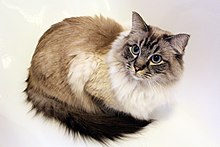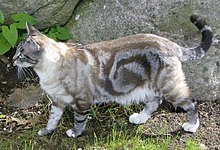Tabby cat: Difference between revisions
Acroterion (talk | contribs) m Reverted edits by 97.85.133.6 (talk) to last version by GB fan |
|||
| Line 21: | Line 21: | ||
===Classic tabby=== |
===Classic tabby=== |
||
The Classic (also known as "Blotched" or "Marbled") tabby tends to have a pattern of dark |
The Classic (also known as "Blotched" or "Marbled") tabby tends to have a pattern of dark pinks, blues and black but also occurs in yellow. Classic tabbies have the "P" pattern on their foreheads but the body markings have a whirled or swirled pattern (often called a "bullseye") on the cat's sides. There is also a light colored "butterfly" pattern on the shoulders and three thin stripes (the center stripe is dark) running along its spine. Like the Mackerel tabby, Classic tabbies have dark bars on the legs, tail, and cheeks. |
||
===Ticked tabby=== |
===Ticked tabby=== |
||
Revision as of 22:59, 3 March 2016

A tabby is any domestic cat that has a coat featuring distinctive stripes, dots, lines or swirling patterns, usually together with a mark resembling an 'M' on its forehead. Tabbies are sometimes erroneously assumed to be a cat breed.[1] In fact, the tabby pattern is found in many breeds, as well as among the general mixed-breed population. The tabby pattern is a naturally occurring feature that may be related to the coloration of the domestic cat's direct ancestor, the African wildcat, which (along with the European wildcat and Asiatic wildcat) has a similar coloration.
Etymology
The English term tabby comes from a translation of the French for "striped silk taffeta", which derives from the French tabis, meaning "a rich watered silk (originally striped)", in turn from Middle French atabis (14th century), from the Arabic term attabiya, from Attabiy, a neighborhood of Baghdad where such cloth was first made, named for Prince 'Attab of the Umayyad Caliphate, as compared to the Spanish term ataviar, meaning "to decorate or to dress or wear" (often implying very elegant and/or expensive clothing).[2] The term tabby cat, "one with a striped coat", is attested from the 1690s; the shortened form tabby was first attested in 1774. The idea of "female cat" (1826) may be influenced by the feminine proper name Tabby, a pet form of Tabitha, which was used in the late 18th century as slang for a "difficult old woman".[3]
Tabby patterns




There are four tabby patterns that have been shown to be genetically distinct:[1][4] Mackerel, Classic, spotted, and ticked.
A fifth includes tabby as part of another basic color pattern. The "patched" tabby is a calico or tortoiseshell cat with tabby patches (also known as "caliby" and "torbie", respectively).[1]
All those patterns have been observed in random-bred populations. Several additional patterns are found in specific breeds. A modified Classic tabby is found in the Sokoke breed. Some are due to the interaction of wild and domestic genes. Rosetted and marbled patterns are found in the Bengal breed.
Mackerel tabby
The mackerel tabby pattern has vertical, gently curving stripes on the side of the body. The stripes are narrow and may be continuous or broken into bars and spots on the flanks and stomach. An "M" shape appears on the forehead along with dark lines across the cat's cheeks to the corners of its eyes. Mackerels are also called 'fishbone tabbies', probably because they are named after the mackerel fish.[5] Mackerel is the most common tabby pattern.
Classic tabby
The Classic (also known as "Blotched" or "Marbled") tabby tends to have a pattern of dark pinks, blues and black but also occurs in yellow. Classic tabbies have the "P" pattern on their foreheads but the body markings have a whirled or swirled pattern (often called a "bullseye") on the cat's sides. There is also a light colored "butterfly" pattern on the shoulders and three thin stripes (the center stripe is dark) running along its spine. Like the Mackerel tabby, Classic tabbies have dark bars on the legs, tail, and cheeks.
Ticked tabby
The ticked (or stripless) tabby pattern produces agouti hairs, hairs with distinct bands of color on them, breaking up the tabby patterning into a "salt-and-pepper" or "sand" like appearance. Residual ghost striping or "barring" can often be seen on the lower legs, face and belly and sometimes at the tail tip, as well as a long dark line running along the back, usually in the spine.
Spotted tabby
The Spotted tabby is a modifier that breaks up the Mackerel tabby pattern so that the stripes appear as spots. Similarly, the stripes of the Classic tabby pattern may be broken into larger spots. Both large spot and small spot patterns can be seen in the Australian Mist, Bengal, Egyptian Mau, Maine Coon, and Ocicat breeds.
Genetic explanations for tabby patterns

The tabby patterns are due to three distinct gene loci and one modifier:
The agouti gene, A/a,[6] controls whether or not the tabby pattern is expressed. The dominant A expresses the underlying tabby pattern, while the recessive non-agouti or "hypermelanistic" allele, a, does not. Solid-color (black or blue) cats have the aa combination, hiding the tabby pattern, although sometimes a suggestion of the underlying pattern can be seen (called "ghost striping") This is mostly seen in young cats that still have the baby coat. The right pattern (classic, mackerel, or spotted) will reveal itself then, because that is independent of whether it is tabby or solid.
However, the agouti gene only controls the production of black pigment, so a cat with an O allele for orange color will still have the tabby pattern. As a result, both red cats and the patches of red on tortoiseshell cats will show tabby striping.
The primary tabby pattern gene, Mc/mc or Mc/Mc, sets the basic pattern of stripes that underlies the coat. Mc is the wild-type tabby gene and produces what is called a Mackerel striped tabby. Classic tabbies are cats who also possess mc/mc, a recessive mutant gene that produces the blotched pattern.
The spotted gene is directly connected to the Mc gene; it 'breaks' the lines of a mackerel tabby, turning it into spots. The spotted gene is dominant as well, which means a spotted will be Sp/sp or Sp/Sp together with Mc/mc and Mc/Mc and A/a and A/A.
The ticked tabby pattern is on a different gene locus than the Mackerel and Classic tabby patterns and is epistatic to the other patterns. A dominant mutation, Ta / ta, masks any other tabby pattern, producing a non-patterned, or agouti tabby, with virtually no stripes or bars. If the ticked tabby pattern gene is present, any other tabby pattern is masked. Cats homozygous for the ticked allele (Ta / Ta) have less barring than cats heterozygous for the ticked allele. When a cat of this genetic make-up is selectively bred for lack of barring and wide banding on the hair shaft, the resulting pattern is referred to as shaded.
History
Since the tabby pattern is a common wild type, it might be assumed that medieval cats were tabbies.[citation needed] However, one writer believed this to be untrue, at least in England. Some time after the mid-17th century, the natural philosopher John Aubrey noted that William Laud, the Archbishop of Canterbury was "a great lover of Cats" and "was presented with some Cyprus-cats, i.e. our Tabby-Cats". He then claimed that "I doe well remember that the common English Catt, was white with some blueish piednesse (i.e. white with grey parts). The race or breed of them are now almost lost."[7]
See also
References
- ^ a b c A Tribute to Tabby Cats in all Their Manifestations. About.com:Cats. Retrieved on January 31, 2008
- ^ ataviar - Definición - WordReference.com. Retrieved on May 6, 2013
- ^ Online Etymology Dictionary
- ^ Cat Colors FAQ Cat Fanciers. Retrieved on January 31, 2008
- ^ "Glossary of Cat Terms". Retrieved November 24, 2009.
- ^ Cats of a Different Color, Agouti. Archived 2008-02-10 at the Wayback Machine
- ^ Oliver Lawson Dick, ed. Aubrey's Brief Lives. Edited from the Original Manuscripts, 1949, p. xxxvi.
